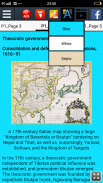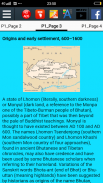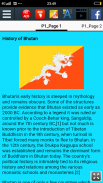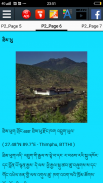










History of Bhutan

Descrição do History of Bhutan
Bhutan's early history is steeped in mythology and remains obscure. Some of the structures provide evidence that Bhutan existed as early as 2000 BC. According to a legend it was ruled or controlled by a Cooch-Behar king, Sangaldip, around the 7th century BC,[1] but not much is known prior to the introduction of Tibetan Buddhism in the 9th century, when turmoil in Tibet forced many monks to flee to Bhutan. In the 12th century, the Drukpa Kagyupa school was established and remains the dominant form of Buddhism in Bhutan today. The country's political history is intimately tied to its religious history and relations among the various monastic schools and monasteries.[2]
Bhutan is one of only a few countries which have been independent throughout their history, never conquered, occupied, or governed by an outside power (notwithstanding occasional nominal tributary status). Although there has been speculation that it was under the Kamarupa Kingdom or the Tibetan Empire in the 7th to 9th centuries, firm evidence is lacking. From the time historical records are clear, Bhutan has continuously and successfully defended its sovereignty.[3]
The consolidation of Bhutan occurred in 1616 when Ngawanag Namgyal, a lama from western Tibet known as the Zhabdrung Rinpoche, defeated three Tibetan invasions, subjugated rival religious schools, codified the Tsa Yig, an intricate and comprehensive system of law, and established himself as ruler over a system of ecclesiastical and civil administrators. After his death, infighting and civil war eroded the power of the Zhabdrung for the next 200 years. In 1885 Ugyen Wangchuck was able to consolidate power, and began cultivating closer ties with the British in the subcontinant.[2]
In 1907, Ugyen Wangchuck was elected as the hereditary ruler of Bhutan, crowned on December 17, 1907, and installed as the head of state, the Druk Gyalpo (Dragon King). In 1910, King Ugyen and the British signed the Treaty of Punakha which provided that British India would not interfere in the internal affairs of Bhutan if the country accepted external advice in its external relations. When Ugyen Wangchuck died in 1926, his son Jigme Wangchuck became ruler, and when India gained independence in 1947, the new Indian Government recognized Bhutan as an independent country. In 1949 India and Bhutan signed the Treaty of Peace and Friendship, which provided that India would not interfere in Bhutan's internal affairs, but would guide its foreign policy. Succeeded in 1952 by his son Jigme Dorji Wangchuck, Bhutan began to slowly emerge from its isolation and began a program of planned development. The National Assembly of Bhutan, the Royal Bhutanese Army, and the Royal Court of Justice were established, along with a new code of law.[2] Bhutan became a member of the United Nations in 1971.
In 1972, Jigme Singye Wangchuck ascended the throne at age 16.[4] He emphasized modern education, decentralization of governance, the development of hydroelectricity and tourism and improvements in rural developments. He was perhaps best known internationally for his overarching development philosophy of "gross national happiness." It recognizes that there are many dimensions to development and that economic goals alone are not sufficient. Satisfied with Bhutan's transitioning democratization process, he abdicated in December 2006 rather than wait until the promulgation of the new constitution in 2008. His son, Jigme Khesar Namgyel Wangchuck, became King upon his abdication.[2]
história inicial do Butão está mergulhada na mitologia e permanece obscura. Algumas das estruturas fornecem evidências de que o Butão existido tão cedo quanto 2000 aC. De acordo com uma lenda foi governado ou controlado por um rei Cooch-Behar, Sangaldip, em torno do século 7 aC, [1] mas não se sabe muito antes da introdução do budismo tibetano no século 9, quando a crise no Tibete obrigou muitos monges a fugir para Butão. No século 12, a escola Drukpa Kagyupa foi estabelecido e continua a ser a forma dominante do budismo no Butão hoje. história política do país está intimamente ligada à sua história religiosa e as relações entre as várias escolas e mosteiros monásticas. [2]
Butão é um dos poucos países que têm sido independente ao longo da sua história, nunca conquistei, ocupado, ou governado por um poder externo (não obstante o status tributário nominal ocasional). Embora tenha havido especulações de que ele estava sob o Reino Kamarupa ou o Império tibetano no 7º ao 9º séculos, evidência firme está faltando. A partir do momento registros históricos são claros, Butão tem defendido de forma contínua e com sucesso a sua soberania. [3]
A consolidação do Butão ocorreu em 1616, quando Ngawanag Namgyal, um lama do Tibete ocidental conhecido como o Zhabdrung Rinpoche, derrotou três invasões tibetanas, subjugado escolas religiosas rivais, codificou a Tsa Yig, um sistema complexo e abrangente da lei, e se estabeleceu como governante sobre um sistema de administradores eclesiásticas e civis. Após sua morte, brigas e guerra civil erodido o poder do Zhabdrung para os próximos 200 anos. Em 1885 Ugyen Wangchuck foi capaz de consolidar o poder, e começou a cultivar laços mais estreitos com os britânicos no subcontinant. [2]
Em 1907, Ugyen Wangchuck foi eleito como o governante hereditária do Butão, coroado em 17 de Dezembro de 1907, e instalado como chefe de Estado, o Druk Gyalpo (Dragon King). Em 1910, o rei Ugyen e os britânicos assinaram o Tratado de Punakha que desde que a Índia britânica não iria interferir nos assuntos internos do Butão se o país aceitou o conselho externo nas suas relações externas. Quando Ugyen Wangchuck morreu em 1926, seu filho Jigme Wangchuck tornou-se governante, e quando a Índia conquistou a independência em 1947, o novo governo indiano reconheceu Butão como um país independente. Em 1949, a Índia e Butão assinaram o Tratado de Paz e Amizade, que desde que a Índia não iria interferir nos assuntos internos do Butão, mas iria orientar a sua política externa. Sucedeu em 1952 por seu filho Jigme Dorji Wangchuck, Butão começou a emergir lentamente de seu isolamento e começou um programa de desenvolvimento planejado. A Assembleia Nacional do Butão, o Exército Real do Butão e da Corte Real de Justiça foram estabelecidos, juntamente com um novo código de direito. [2] Butão tornou-se membro das Nações Unidas em 1971.
Em 1972, Jigme Singye Wangchuck ascendeu ao trono na idade 16. [4] Ele enfatizou a educação moderna, a descentralização da governação, o desenvolvimento da hidroeletricidade e turismo e melhorias no desenvolvimento rural. Ele foi talvez mais conhecido internacionalmente por sua filosofia de desenvolvimento global da "felicidade interna bruta." Ela reconhece que há muitas dimensões para o desenvolvimento e que as metas econômicas por si só não são suficientes. Satisfeito com o processo de democratização transição do Butão, ele abdicou em dezembro de 2006, em vez de esperar até a promulgação da nova Constituição em 2008. Seu filho, Jigme Khesar Namgyal Wangchuck, tornou-se rei em cima de sua abdicação. [2]

























